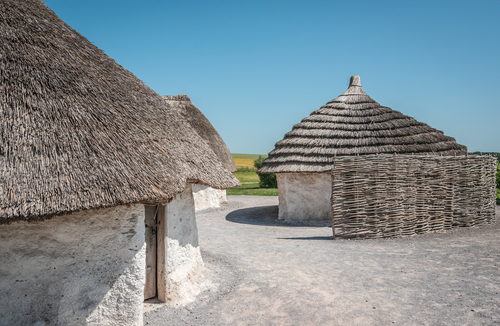The Stone Age, a time shrouded in the mists of antiquity, serves as the distant anchor to our shared human heritage.
Stretching back millions of years, this prehistoric epoch witnessed the remarkable ascent of Homo sapiens from primitive toolmakers to architects of civilizations. In our quest to fathom the tapestry of human history, we must begin at the beginning – the Stone Age.
This era, divided into the Paleolithic, Mesolithic, and Neolithic periods, laid the foundations for our species’ extraordinary journey.
From rudimentary stone tools to breathtaking cave art, and the transformative leap from nomadic hunter-gatherers to settled agriculturists, the Stone Age is a testament to our ingenuity, adaptability, and relentless pursuit of progress.
Stone Age Facts
1. Long Duration: Spanned from 2.5 million years ago to about 4,000 years ago
The Stone Age was an incredibly long period in human history, lasting from approximately 2.5 million years ago to about 4,000 years ago.
Also Read: Timeline of the Stone Age
This extended time frame is divided into three primary stages: the Paleolithic, Mesolithic, and Neolithic eras. Each of these stages witnessed significant advancements and changes in human society and technology.

2. Paleolithic Era: The earliest and longest period, characterized by stone tools
The Paleolithic Era, often referred to as the Old Stone Age, represents the earliest and most extended phase of the Stone Age. It began with the emergence of the first stone tools, which were simple and essential for survival.
Also Read: Iron Age Timeline
Throughout the Paleolithic period, humans were primarily nomadic hunter-gatherers. They relied on hunting animals, fishing, and foraging for wild plants and fruits to sustain themselves.
This era saw the development of various stone tool types, including hand axes, spears, and knives, which were crucial for hunting, food preparation, and defense.
3. Hunter-Gatherers: People relied on hunting, fishing, and foraging for survival
During the Paleolithic Era, humans lived as hunter-gatherers. This means they did not engage in agriculture or practice farming but rather relied on their environment for sustenance. Hunting was a central activity, with early humans targeting large game animals like mammoths, bison, and deer.
Fishing was also an essential part of their diet, as was foraging for edible plants and fruits. These early societies were highly mobile, following the movements of prey animals and the seasonal availability of plants.
The lifestyle of hunter-gatherers required a deep understanding of their surroundings, the ability to track animals, and the knowledge of which plants were safe to eat.
It was a period of profound adaptation and innovation as humans gradually developed the skills and tools necessary for survival in various environments.
4. Tools and Weapons: Stone tools and weapons were crucial for daily life
Stone tools and weapons were central to life during the Stone Age. Initially, tools were quite simple, but over time, they became more sophisticated. Here are some examples of these tools and their uses:
- Hand Axes: These were among the earliest stone tools and were versatile for cutting, chopping, and even as weapons.
- Flint Knives: Used for precise cutting and butchering of animals.
- Spears: These were crafted for hunting and self-defense, often tipped with sharpened stones or bone.
- Arrowheads: Developed in later periods, arrowheads were essential for hunting at a distance.
- Scrapers: Used for processing animal hides and plant materials.
- Grinding Stones: Used for grinding grains and seeds into flour.
- Choppers: Tools with a chopping edge, useful for various tasks.

5. Cave Art: Early examples of art in the form of cave paintings
Some of the most captivating remnants of the Stone Age are the cave paintings and engravings found in various locations around the world. These artworks provide glimpses into the artistic talents and spiritual beliefs of early humans. The most famous examples include:
- Lascaux Cave (France): Known for its intricate depictions of animals like horses, bison, and deer.
- Altamira Cave (Spain): Features striking images of bison and other animals.
- Chauvet Cave (France): Contains some of the earliest known cave art, dating back over 30,000 years.
These artworks not only showcase early humans’ creative abilities but also offer insights into their relationship with the natural world and their belief systems.
6. Domestication of Fire: Control and use of fire for warmth and cooking
The control and use of fire marked a crucial milestone in human development during the Stone Age. Fire had multiple purposes:
- Warmth and Light: Fire provided warmth and protection against predators during the night.
- Cooking: Cooking food made it more digestible and safe to eat, which had significant nutritional benefits.
- Toolmaking: Fire was used to harden wooden tools and to facilitate the crafting of more complex tools.
- Social Benefits: Gathering around a fire fostered social bonds and allowed for storytelling and communal activities.
Mastering fire not only improved survival but also had profound cultural and cognitive effects on early humans. It was a crucial step in the development of technology and played a pivotal role in shaping our species.
7. Mesolithic Era: A transitional phase with smaller, specialized tools
The Mesolithic Era, also known as the Middle Stone Age, followed the Paleolithic and preceded the Neolithic. This transitional period marked several important developments:
- Smaller, Specialized Tools: During the Mesolithic, stone tools became smaller and more specialized. They were finely crafted for specific tasks like fishing, woodworking, and hunting smaller game.
- Semi-Sedentary Lifestyle: While still reliant on hunting, fishing, and gathering, some Mesolithic communities began to settle in semi-sedentary villages. This was a significant shift towards more stable living arrangements compared to the nomadic lifestyle of the Paleolithic.
The Mesolithic laid the groundwork for the subsequent Neolithic Revolution by demonstrating the potential for settled communities and more advanced toolmaking.

8. Neolithic Revolution: Marked by agriculture and the birth of farming communities
The Neolithic Era, or New Stone Age, was a pivotal period in human history. It began around 10,000 years ago and was characterized by several transformative changes:
- Agriculture: The most significant shift was the development of agriculture. People began cultivating crops like wheat, barley, rice, and legumes, as well as domesticating animals such as sheep, goats, cattle, and pigs.
- Settlements: With a stable food supply, people could establish permanent settlements, leading to the growth of early villages and towns.
- Surplus and Trade: Agriculture produced surpluses, enabling trade and specialization of labor, which laid the foundation for complex societies.
- New Technologies: Advanced tools, pottery, and more efficient farming methods emerged, improving productivity and quality of life.
The Neolithic Revolution marked the transition from a predominantly hunter-gatherer lifestyle to one based on agriculture, which had far-reaching impacts on human society, including the development of complex civilizations.
9. Rise of Agriculture: Cultivation of crops and domestication of animals
Agriculture was a hallmark of the Neolithic Era, and it brought about significant changes in human society:
- Food Security: Farming provided a more reliable and abundant food source compared to hunting and gathering.
- Population Growth: Surpluses of food allowed populations to grow, leading to larger communities.
- Specialization: As people settled in one place, they could specialize in various professions, such as farming, toolmaking, pottery, and more.
- Property Ownership: With settled communities, notions of property and land ownership emerged, shaping social hierarchies.
Agriculture revolutionized human existence, leading to the rise of complex societies, the development of written language, and the eventual emergence of civilizations.
10. Technological Advances: Development of pottery, weaving, and megalithic structures
- Beyond stone tools, the Stone Age witnessed several technological advancements during the Mesolithic and Neolithic Eras:
- Pottery: The crafting of pottery containers for cooking, storage, and transportation became widespread, aiding in food preservation.
- Weaving: The development of textiles allowed for the creation of clothing and other fabric-based goods.
- Megalithic Structures: During the later Neolithic period, massive stone structures like Stonehenge were constructed for religious, ceremonial, or astronomical purposes.
These technological innovations improved daily life, enabled the growth of settlements and trade, and played a pivotal role in the progression from simpler societies to more complex civilizations during the later Bronze Age and Iron Age.
